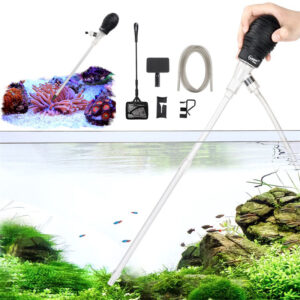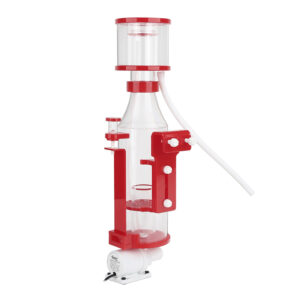Ever wondered what lies beneath the vibrant seascapes? Coral reefs, teeming with life, are made up of numerous coral lifeforms. But these aren’t just colorful rocks! Today, we’ll plunge into the fascinating world of coral, exploring the different types, the champions of hardness, and the challenges of keeping them in our home aquariums. Is coral tank high maintenance? We’ll crack the code on fragmenting the toughest corals and unveil the secrets to keeping them thriving in your reef tank with proper coral tank maintenance!
Content Table

Coral tank maintenance
Features of a Coral Tank
Coral tanks, commonly referred to as reef tanks, are the types of aquariums that mimic the appearance of a small reef ecosystem. They are full of many colored corals, different fish species, and a range of other marine life. However, before setting up your saltwater aquarium, there are a few crucial things that must be kept in mind.
- Livestock
Contrary to popular belief, corals are the core actors, with little ones that live in the same habitat also being an influential part of the ecosystem, like for example, various types of fish, invertebrates, and algae.
- Lighting
Coral reefs are the shallow areas of the sea that receive very bright sunlight. To do that same spectral light, the reef tanks have to use special high-intensity lighting, which mimics the natural light spectrum.
- Filtration
The filtration system of reef tanks must be powerful enough to keep water quality. That usually involves a protein skimmer that pulls out organic matter and a biological filter that changes harmful ammonia into less harmful nitrate.
- Water Movement
Corals thrive in the Bohr effect of continually moving water. Powerheads are responsible for the creation of this water flow in a reef aquarium, which is crucial for gas exchange and getting nutrients to corals.
- Live Rock
Live rock is a spongy support that contains beneficial bacteria that consume toxic waste products. In addition, it serves as a natural substrate to which many corals and other organisms attach.
- Maintenance Requirements
Coral tanks are more challenging to maintain than freshwater tanks. Water parameters such as temperature, salinity, and alkalinity need to be monitored and adjusted regularly. Coral reefs are also sensitive to nutrient levels, so regular water changes are essential.
- Temperature: The ideal temperature for a reef tank is between 78-82°F (25-28°C).
- Salinity: Coral tank salinity should be between 1.025 and 1.026 specific gravity.
- Calcium (Ca): Calcium is essential for coral growth. The recommended level of calcium is 400-450 ppm.
- Nitrate (NO3): Nitrate is a nutrient that can harm corals if it gets too high. The ideal level of nitrate is less than 20 ppm.
- Phosphate (PO4): Phosphate is another nutrient that can harm corals. The ideal level of phosphate is less than 0.05 ppm.
- Alkalinity (KH): Alkalinity helps to maintain stable pH levels in a reef tank. The recommended level of alkalinity is 8-12 dKH.
- Magnesium (Mg): Magnesium is another element that is essential for coral growth. The recommended level of magnesium is 1300-1400 ppm.

Is coral tank high-maintenance
Does a Coral Tank Require a Lot of Maintenance?
Yes, the water of coral tanks needs more preventive measures & maintenance to perform well than freshwater tanks. They are chemical-sensitive weather indicators that require ongoing levels of temperature, salinity, and mineral control. Routine maintenance of water is always on top of the list for coral’s good health. You’d have to be brave enough for this to be a showpiece on your aquarium shelf but rewarding and breathtaking!
Coral Tank Maintenance Points
Here are key points to keep your reef healthy and those precious corals thriving.
- Water Parameters: Regularly monitor and adjust temperature, salinity, calcium, alkalinity, and nutrient levels (nitrates & phosphates) to mimic a stable coral reef environment.
- Water Changes: Perform regular water changes (typically weekly or bi-weekly) to remove waste products and replenish essential minerals.
- Equipment Care: Clean and maintain protein skimmers, filters, and powerheads to ensure proper water quality and circulation.
- Gentle Touch: Be extra careful during maintenance. Use a coral feeder to gently remove debris near corals and avoid directly touching delicate polyps.
- Fragile & Expensive Coral Care: For expensive or fragile corals, consider frag racks or temporary relocation during maintenance to minimize stress and accidental damage.

Coral tank maintenance points
Guide for Coral Fish Tank Maintenance
Here’s a detailed guide to coral tank maintenance.
Daily Maintenance
- Observe: Find a few minutes every day dedicated to the observation of your coral and other aquatic life. Check for signs of stress, sickness, or coloration.
- Check Equipment: Set up all equipment like pumps, protein skimmers, and filters, and be certain that everyone is working correctly. Make note of strange noises and look for leaks.
- Temperature & Salinity: Very short, sample the water temperature and salinity with high precision, thermometer and hydrometer.
Weekly Maintenance
- Water Testing: Monitor your water for important contaminants: pH, alkalinity, calcium, magnesium, nitrates, and phosphate levels. Implement a way to monitor readings for identification of the trends.
- Water Change: Provide 10-20% of water change to the tank volume and set the initial saltwater level. Find the needed temperature and salinity for the new water and compare it with the old tank water.
- Glass Cleaning: Apply an algae magnet cleaner or soft cloth to get rid of ones from the inside surfaces of the tank.
- Top Off Water Level: Levels of salinity might escalate as a result of evaporation. On top, of the saltwater tank, add up to the right level of pre-mix salt water to keep the target level.
Bi-Weekly/Monthly
- Filter Maintenance: It is important to adhere to the filter media manufacturer’s instructions, so either clean or replace the filter media. First, do not clean everything at the same time because in another way you will destroy useful bacteria.
- Powerhead Maintenance: Check the cleanliness of bottom feeders to facilitate proper water flow.
- Sandbed Cleaning: Instead of hands, use a cleaning set to mix sand bed softly that does not move the good bacteria, but only removes sludge.

Additional maintenance
Additional Maintenance (Based on needs)
- Coral Feeding: Certain corals get to be the darlings of the tank and get fed plankton or mysis shrimps during special feedings. Research the feeding regime and other conditions essential for your coral type.
- Coral Placement: Because corals grow as they become larger, re-organizing is necessary sometimes to ensure that they are in good spots for light and water movement. Use effectors, such as frag racks or coral plugs, to properly position them. These considerations will ensure the ideal location and successful growth of the corals.
- Frag Propagation: And, so long as the corals are in perfect health, they can be propagated (fragged) to produce new colonies. Steer clear of any techniques that may injure the parent coral.
Protecting Your Precious Corals
- Minimize Stress: Work carefully and save time when doing maintenance work to ensure that the corals aren’t thrown off balance.
- Coral Feeder Kit: Apply a coral feeder to dislodge debris or feed corals to avoid touching anemones. Care should therefore be applied.
- Fragile & Expensive Coral Care: For those corals that can be considered rare or overly expensive, space them out a bit or move them to a different tank during maintenance to reduce breakage risk.
Key Takeaways
What is finally worth mentioning is that keeping a coral tank is an act of responsibility, yet at the same time, the process is enjoyable and worthwhile. It necessitates constant control of water chemistry, water flushing, care for tools and apparatus, as well as locomotion of polyps via gentle touch. Through the above-mentioned steps and by creating a suitable environment, you will surely end up with a very large reef ecosystem in your home aquarium.



Leave a comment